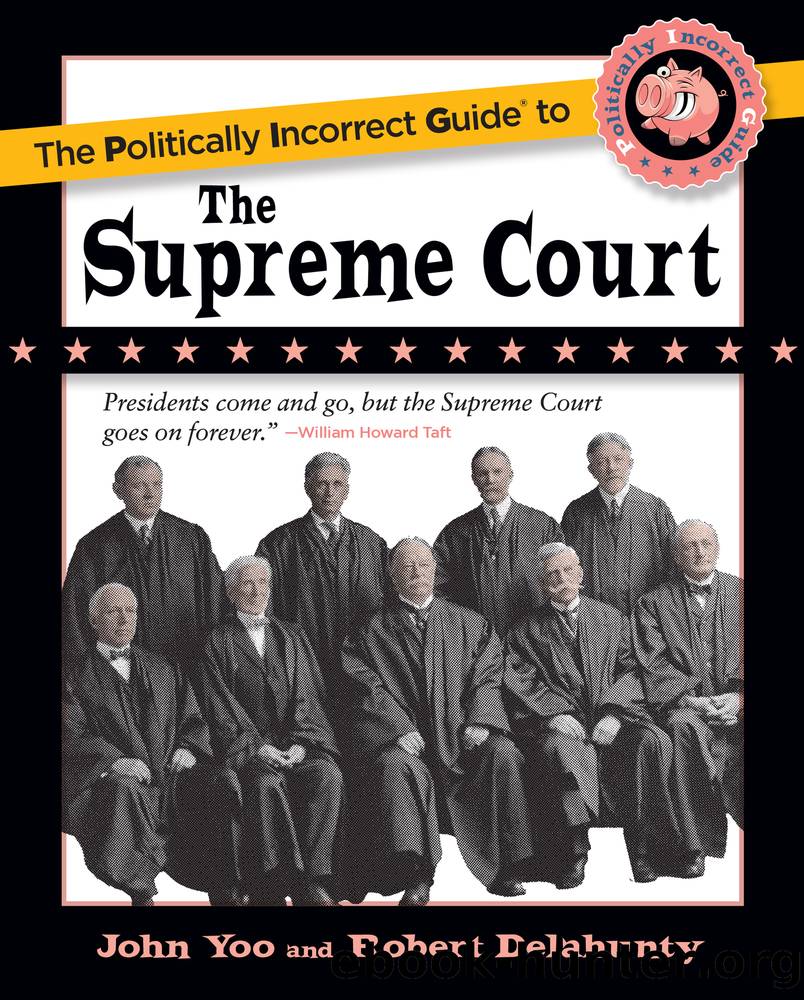The Politically Incorrect Guide to the Supreme Court by John Yoo & Robert J. Delahunty

Author:John Yoo & Robert J. Delahunty
Language: eng
Format: epub
Publisher: Regnery Publishing
Published: 2023-06-27T00:00:00+00:00
Justice Kavanaugh also noted the limits of the Heller, McDonald, and Bruen holdings. He stated that Bruen did not affect the âshall issueâ licensing schemes found in forty-three states: these states, he wrote, could continue to enforce their laws. (Presumably, Kavanaugh believed that âshall issueâ laws had the requisite historical validation.) The âmay issueâ states like New York could continue to require licenses for carrying handguns for self-defense, provided that they used âobjective licensing requirementsâ like those of the forty-three states. Kavanaugh tracked Heller (and, indeed, the majority opinion in Bruen itself) in pointing out that the Second Amendment, while not âa regulatory blank check,â was also not âa regulatory straitjacket.â There were important boundaries to the amendmentâs protections, including (for example) state prohibitions on carrying handguns into âsensitiveâ places.15
Predictably, some of the reactions to Bruen were extremely hostile. New York State was among the first to denounce the decision and to enact broadened gun control regulation. State Attorney General Letitia James argued that the Court had not struck down the stateâs licensing requirements for handguns in their entirety; that the Court had seemed to endorse many of the licensing requirements (for example, fingerprinting, background checks, and so forth) common to New York and âmust issueâ states; that carrying in âsensitive placesâ might be prohibited; that âunusual weaponsâ were âsubject to further restrictionsâ; that âcarrying guns with unlawful intentâ might be prohibited; and that private property owners might be authorized to ban guns on their property. She also noted that New York governor Kathy Hochul had recently signed legislation, adopted at a special session of the state legislature, to strengthen gun control regulations by characterizing additional public settings as âsensitive places,â by adding new eligibility requirements for applicants seeking a concealed-carry permit, and by imposing new storage and other safety requirements.16
Meanwhile, just hours after Bruen was issued, the U.S. Senate, by a 65â33 vote, passed the Bipartisan Safer Communities Act, a significant piece of gun control legislation. The Senate bill swiftly passed the House and was signed into law. Among other things, the new federal act provided funding to states to enact and implement so-called âred flagâ laws and closed the so-called âboyfriend loopholeâ in prior law.17
Whether these and other state and federal gun control laws will survive judicial review under Bruenâs standards is difficult to predict. In a separate concurring opinion in Caniglia v. Strom, a 2021 Fourth Amendment case involving a warrantless police seizure of handguns within a home, Justice Alito had been careful to note that the Courtâs decision in that case did not affect âthe so-called âred flagâ laws that some states are now enacting.â Alito explained that these laws âenable the police to seize guns pursuant to a court order to prevent their use for suicide or the infliction of harm on innocent persons.â Alito observed that Fourth Amendment challenges to such âred flagâ laws were likely.18 So now are Second Amendment challenges. Unless states can establish that their red flag laws are analogous to traditional gun control legislation, those laws may well fail to satisfy Bruen.
Download
This site does not store any files on its server. We only index and link to content provided by other sites. Please contact the content providers to delete copyright contents if any and email us, we'll remove relevant links or contents immediately.
The Secret History by Donna Tartt(16676)
The Social Justice Warrior Handbook by Lisa De Pasquale(11495)
Thirteen Reasons Why by Jay Asher(7808)
This Is How You Lose Her by Junot Diaz(5802)
Weapons of Math Destruction by Cathy O'Neil(5055)
Zero to One by Peter Thiel(4840)
The Myth of the Strong Leader by Archie Brown(4796)
Promise Me, Dad by Joe Biden(4460)
Beartown by Fredrik Backman(4442)
How Democracies Die by Steven Levitsky & Daniel Ziblatt(4427)
Stone's Rules by Roger Stone(4426)
The Fire Next Time by James Baldwin(4354)
100 Deadly Skills by Clint Emerson(4091)
A Higher Loyalty: Truth, Lies, and Leadership by James Comey(4044)
Rise and Kill First by Ronen Bergman(4026)
The David Icke Guide to the Global Conspiracy (and how to end it) by David Icke(3899)
The Farm by Tom Rob Smith(3883)
Secrecy World by Jake Bernstein(3793)
The Doomsday Machine by Daniel Ellsberg(3742)
